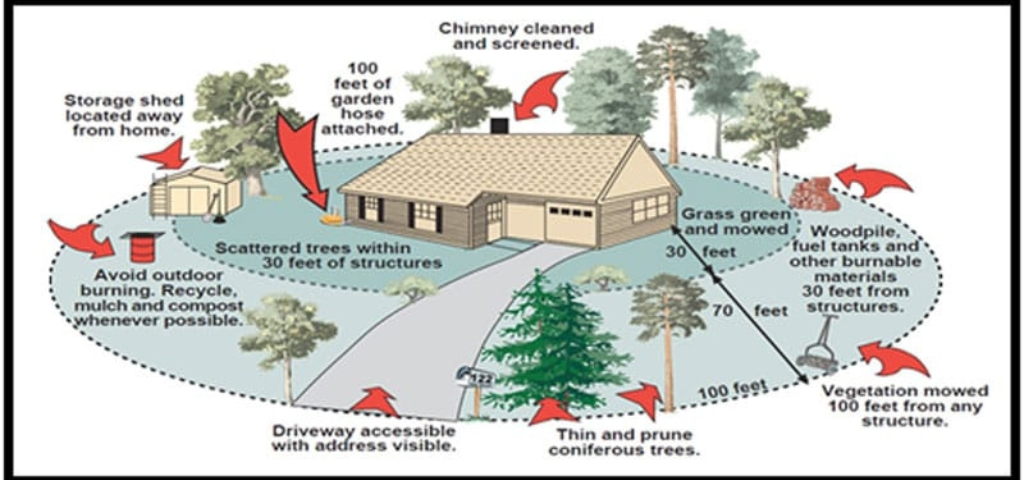Common Sense Defensible Spaces
The Foothills of the Rocky Mountains west of Denver offer breathtaking views and a close connection to nature. However, this picturesque setting also comes with the annual risk of wildfires. As these events become more frequent and intense, creating defensible spaces around homes is vital to protect property and valuables, as these spaces help to block or slow the spread of fire to your home.
This article provides updated, actionable guidelines to help homeowners in the foothills effectively safeguard their properties. We’ll explore how a combination of common sense and strategic planning can greatly increase the safety of mountain homes in the face of growing wildfire threats.
Understanding Defensible Spaces in Dry Mountain Settings
A defensible space in wildfire-prone areas refers to a strategic buffer zone around a home where vegetation and other combustible materials have been modified or removed to reduce wildfire spread. It’s not about clear-cutting all vegetation but creating an effective buffer that can impede a fire’s progress while maintaining the natural beauty of your property.
Defensible spaces serve two primary roles:
- They act as a barrier to slow or potentially stop the advance of a wildfire, keeping the flames away from your home.
- They provide a safer operational area for firefighters if they need to defend the property.
By implementing these spaces, homeowners not only protect individual properties but also contribute to the overall fire resilience of mountain communities. It’s beneficial for neighbors to coordinate their firewise landscaping efforts.
Defensible spaces are not barren landscapes! With informed landscaping choices and consistent maintenance, it’s possible to significantly reduce fire risk while preserving much of the natural beauty and vegetation that makes mountain living appealing. The key lies in intentional plant selection, placement, and upkeep.
How Defensible Spaces Protect Homes and Aid Firefighters
Here are a few of the key benefits of creating a straightforward, common sense defensible space:
- Reduced Fire Intensity: Less vegetation means lower heat levels and slower fire spread.
- Increased Home Survivability: Lower wildfire fuel near the home significantly lowers the chance that flames will spread to the structure.
- Improved Firefighter Safety: Clear zones around key structures allow firefighters to operate more safely and efficiently.
- Better Access: Clear areas around homes provide easier access for emergency vehicles.
- Easier Evacuation: Well-maintained defensible spaces improve escape routes for residents during emergencies.
- Insurance Benefits: Homes with defensible spaces may qualify for better insurance rates and coverage.
- Environmental Health: Managed vegetation promotes a healthier, more resilient forest ecosystem while still allowing you to enjoy a beautiful, natural property.

The Common Sense Approach to Defensible Spaces
Creating an effective defensible space doesn’t require the complete removal of all trees and vegetation from your property. Removing all greenery not only makes your property less attractive and less valuable, but it also harms the local ecosystem. Clearcutting your land may not effectively mitigate wildfire risk, either.
Instead, use common sense when creating defensible spaces. Some vegetation and trees are beneficial and can even contribute to fire mitigation when properly managed. Maintaining a balanced approach by following guidelines ensures that your property remains beautiful, supports the local ecosystem, and is better protected from wildfires. The key is to strategically thin out vegetation, remove dead trees or highly flammable materials, and create breaks in the landscape to slow down any potential fires.
Assessing Your Property: Are You Currently At-Risk?
Before you start hacking away at your landscape, it’s important to take stock of how safe or risky your landscape is. Begin by examining the overall layout of your property to understand how fire might spread. Pay attention to the type and condition of trees and shrubs, ensuring they are well-spaced and trimmed. Evaluate the condition of your roof, gutters, and other structures for any accumulated debris that could ignite during a wildfire.
- Check Vegetation: Identify dense brush, dead plants, and flammable materials (such as dry leaves, pine needles, deadwood, and dried grass) within 100 feet of your house.
- Identify Fire Hazards: Look for wooden decks, overhanging branches, and piles of leaves or firewood near your home, garage, or other structures.
- Evaluate Tree and Shrub Spacing: Ensure trees and shrubs are well-spaced and trimmed. Areas of dense vegetation are more at risk. Only some plants or trees may need to be removed, allowing you to maintain some of your valuable vegetation.
- Inspect Roof and Gutters: Check for accumulated debris like leaves or pine needles that could easily ignite.
- Understand Fire Spread: Assess the overall layout to determine potential fire paths.
Creating an Effective Defensible Space
The creation of a defensible space typically involves establishing three distinct zones around your home, each with specific management strategies:
- Immediate Zone (0-5 feet): This zone is critical for reducing the chances of direct flame contact or ember ignition on your home.
- Intermediate Zone (5-30 feet): This area focuses on reducing fire intensity and slowing its spread.
- Extended Zone (30-100 feet): The goal in this zone is to reduce the energy of the fire and slow its progress.
For more detailed steps and additional fire mitigation strategies, check out our comprehensive guide on creating fire wise landscapes in the Colorado foothills.
You can also check out some of these local resources:
- Colorado State Forest Service – Wildfire Mitigation
- Ready, Set, Go! Program
- FEMA – Wildfire Safety
- Firewise USA
Save Your Trees! Out of fear, many homeowners want to remove all the mature trees from their properties in hopes of keeping their homes safe. However, larger, mature trees are usually the most fire-resistant and the least likely fuel source for wildfires. In many cases, you can spare your big trees and focus on clearing ladder fuels (lower vegetation).
Best Practices for Tree and Vegetation Management
Effective tree and vegetation management is crucial for maintaining a defensible space while preserving the natural beauty of your property. Here are some key practices:
- Strategic Thinning: Reduce tree density in heavily wooded areas to prevent crown fires.
- Pruning: Regularly prune trees to remove dead branches and maintain appropriate height.
- Species Selection: When replanting, choose fire-resistant plants that are well-suited to the local climate.
- Hardscapes: Use stone or gravel to create additional firebreaks in your landscape.
- Maintenance Schedule: Implement a regular maintenance routine to keep your defensible space effective year-round.
- Green Belts: Consider creating irrigated green belts with fire-resistant plants to serve as additional fire breaks.
Common Misconceptions about Defensible Spaces
When it comes to creating defensible spaces, homeowners often fall into two extreme camps: those who want to clear-cut everything in sight, and those who believe any effort is futile. Let’s address these misconceptions and find a balanced, informed approach to wildfire mitigation.
Myth 1: “Clear-cutting is the safest option”
Reality: Completely removing all vegetation can lead to erosion issues and doesn’t necessarily provide the best protection. A well-managed landscape with appropriate plants can actually help slow fire spread.
Myth 2: “Defensible spaces are unattractive”
Reality: With proper planning and plant selection, a defensible space can be both safe and aesthetically pleasing. Many native, fire-resistant plants are beautiful additions to any landscape.
Myth 3: “Creating a defensible space is too expensive”
Reality: While there may be initial costs, many aspects of creating a defensible space can be done gradually and cost-effectively. The potential savings in terms of property protection far outweigh the expenses.
Myth 4: “Once created, a defensible space requires no maintenance”
Reality: Defensible spaces require ongoing maintenance to remain effective. Regular upkeep is essential to manage vegetation growth and remove accumulated debris.
Myth 5: “It’s hopeless to try to protect against wildfires”
Reality: This defeatist attitude is both inaccurate and potentially dangerous. Studies and real-world examples demonstrate that proper defensible spaces significantly increase a home’s chances of surviving a wildfire. Even if homeowners aren’t present during a fire, these spaces aid firefighters in protecting properties. Moreover, homes with defensible spaces often suffer less damage and provide safer evacuation conditions, even in severe fire events. While we can’t completely control wildfires, taking proactive steps can substantially reduce risks and improve outcomes.
Professional Assistance: When and Why to Consult a Fire Safety Professional
If you’re unsure about your property’s fire risk or how to create a defensible space, consider consulting a fire safety professional. These experts provide comprehensive risk assessments, identifying specific vulnerabilities and recommending targeted mitigation measures. They can advise on best practices for vegetation management, structural improvements, and emergency preparedness, ensuring your property is well-protected.
Professional assistance is particularly valuable for properties with complex landscapes or those in high-risk areas. Additionally, they can help you understand local fire regulations and compliance requirements, ensuring your efforts meet community standards and enhance overall safety. Don’t let fire mitigation be an afterthought. Proper protection is crucial for safeguarding your home, especially in wildfire-prone areas.
Common Sense Defensible Spaces: Protect Your Home from Wildfires - LAM Tree Service
Your guide to common sense defensible spaces around your home. Learn how to protect your m...
Selling Your Home?
Get your home's value - our custom reports include accurate and up to date information.





